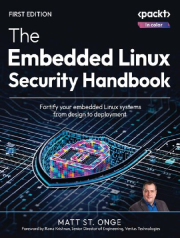
عنوان:
The Embedded Linux Security Handbook
نویسنده:
Matt St. Onge
انتشارات:
Packt
تاریخ انتشار:
2025
حجم:
3.1MB
معرفی کتاب:"راهنمای امنیت لینوکس تعبیهشده: تقویت امنیت سیستمهای لینوکسی از طراحی تا اجرا "
نویسنده: مت سنتآنج (Matt St. Onge)
همراه با نسخه PDF رایگان و دسترسی به جامعه حرفهای توسعهدهندگان سیستمهای تعبیهشده
آنچه خواهید آموخت:
- انتخاب سختافزار مناسب و امن برای طراحی سیستم
- درک اصول طراحی ایمن سیستمهای تعبیهشده
- اجرای تکنیکهایی مانند Secure Boot، رمزنگاری LUKS، TPM
- بهروزرسانی ایمن و خودکار دستگاهها
- مدیریت امن چرخه عمر سیستم و زنجیره تأمین نرمافزار
- محدودسازی سطح دسترسی و کاهش سطح حمله
مخاطبان:
مهندسان سیستمهای تعبیهشده، توسعهدهندگان نرمافزار لینوکسی، معماران امنیت نرمافزار، مدیران محصول و مدیران فنی که به امنیت در سطوح سختافزار و نرمافزار اهمیت میدهند.
درباره کتاب:
در دنیای امروز که تهدیدات سایبری روبهافزایشاند، دستگاههای لینوکس تعبیهشده در صنایع مختلف از خودرو تا IoT و تجهیزات پزشکی، به هدفهای بالقوهای تبدیل شدهاند. این کتاب با تکیه بر بیش از ۳۰ سال تجربهی نویسنده، نگاهی کاربردی و جامع به امنیت این سیستمها دارد و به شما کمک میکند دستگاههایی بسازید که هم امن و هم قابل اعتماد باشند.
«در دنیایی که تهدیدات امنیت سایبری رو به افزایشاند، این کتاب شکاف مهمی را پر میکند و راهنمایی کامل برای ایمنسازی سیستمهای تعبیهشدهی لینوکسی ارائه میدهد.»
— راما کریشنان، مدیر ارشد مهندسی در Veritas Technologies
فهرست مطالب
- Contents
- Cover
- Title page
- Copyright and credits
- Dedication
- Foreword
- Author’s Note
- Contributors
- Table of Contents
- Preface
- Part 1: Introduction to Embedded Systems and Secure Design
- Chapter 1. Welcome to the Cyber Security Landscape
- What is a Linux-embedded system?
- How are Linux-embedded systems used?
- Why is securing Linux-embedded systems so important?
- Summary
- Chapter 2. Security Starts at the Design Table
- What are the business needs that the solution caters to?
- Who is my target buyer and my target user?
- Will any specific government compliance standards drive the decision tree?
- How will we support this appliance solution?
- Other product-impacting needs and concerns
- Summary
- Chapter 3. Applying Design Requirements Criteria – Hardware Selection
- What are the targeted performance requirements?
- Are there any environmental limitations?
- COTS versus custom-built hardware
- What mainstream CPU/hardware platforms are available?
- Summary
- Chapter 4. Applying Design Requirements Criteria – the Operating System
- Matching an operating system to your base hardware platform
- Driver support, vendor support, and stability
- Enterprise versus community distributions of Linux
- Lifecycle of operating systems versus your solution
- Hard costs versus soft costs
- Summary
- Part 2: Design Components
- Chapter 5. Basic Needs in My Build Chain
- Technical requirements
- Software supply chain control
- Automation and tool integration – a brief overview
- Security scanning, testing, and remediation
- Manifest and configuration tracking
- Update control mechanisms
- Summary
- Chapter 6. Disk Encryption
- Technical requirements
- Introduction to LUKS
- Implementing LUKS on an appliance with automated keys
- Is recovery possible?
- Summary
- Chapter 7. The Trusted Platform Module
- What is TPM?
- Configuring TPM by example
- Summary
- Join our community on Discord
- Chapter 8. Boot, BIOS, and Firmware Security
- Deep dive into various booting system components
- Understanding boot-level security using examples
- Possible threats in firmware
- Summary
- Chapter 9. Image-Based Deployments
- Technical requirements
- Introducing image-based Linux deployments
- bootc and bootable container images
- Limitations of image-based deployments
- Updating and rolling back changes
- Practical exercises
- Summary
- Chapter 10. Childproofing the Solution
- Introduction to child-proofing
- Ensuring hardware-level protections
- Operating-system-level and application protections
- Building a UI for configuration and UX
- Summary
- Part 3: The Build Chain, Appliance Lifecycle, and Continuous Improvement
- Chapter 11. Knowing the Threat Landscape – Staying Informed
- Navigating the information and disinformation online
- Knowing what vulnerabilities can impact your builds
- Being part of the solution
- Summary
- Chapter 12. Are My Devices’ Communications and Interactions Secure?
- Technical requirements
- Bus types and issues
- Enhancing security with certificates
- Confirming that your networking is secure
- Limitations of legacy hardware and software
- Validating your solution before shipping
- Summary
- Chapter 13. Applying Government Security Standards – System Hardening
- Technical requirements
- Adherence to key US government standards
- How do I implement this?
- How do I certify my solution?
- Summary
- Chapter 14. Customer and Community Feedback Loops
- Use case development
- User groups
- Executive roundtables
- Community feedback loops
- Summary
- Closing the loop
- Join our community on Discord
- Index
- Why subscribe?
- Other Books You May Enjoy
- Packt is searching for authors like you
- Share Your Thoughts
- Download a free PDF copy of this book
مشخصات
نام کتاب
The Embedded Linux Security Handbook
نویسنده
Matt St. Onge
انتشارات
Packt
تاریخ انتشار
2025
ISBN
9781835885642
تعداد صفحات
278
زبان
انگلیسی
فرمت
حجم
3.1MB
موضوع
linux security, cybersecurity
